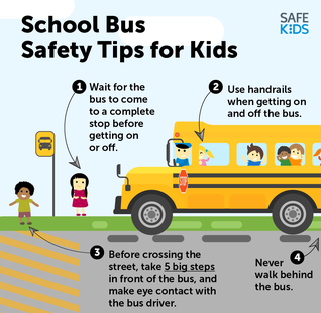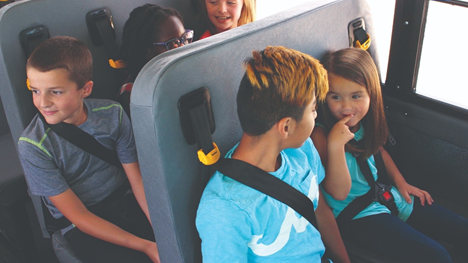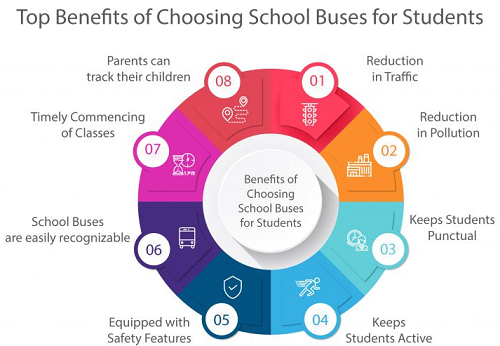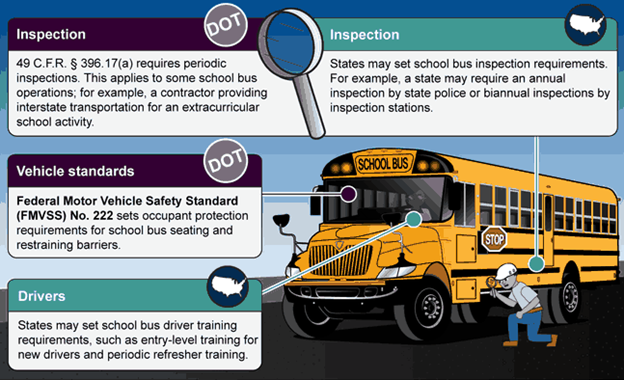Important Safety and Security Instructions Related to School Transportation
- On Jul, 27, 2023
- Admin
Our children are the most important thing that God almighty has given us in this life, so it is our duty towards them to protect them and preserve their safety whether if they are with us or alone. Every year in America, 121 people are killed in school bus accidents, according to the National Highway Traffic Safety Administration (NHTSA). As per NHTSA statistics, there were 1,207 fatalities due to school bus accidents between 2009 and 2018.
![]()
School buses are reported as being a relatively safer mode of school travel. Yet, between 2008 and 2017, there were 1113 fatal crashes, accounting for about 0.4% of total fatal motor vehicle crashes that were classified as school transportation related. These crashes killed 1241 people, averaging 124 fatalities per year. A breakdown of the fatalities shows that 10% of the casualties were school bus occupants, 20% were non-occupants, and 70% were occupants of other vehicles. Of the 10%, casualties who were school bus occupants, 55 were drivers and 71 were passengers. Furthermore, 264 (21%) of the 1241 deaths were of school-age children, of which 61 were school bus occupants, 100 were occupants of other vehicles, and 102 were either pedestrians or cyclists. (Lidbe, Abhay, Emmanuel Kofi Adanu, Elsa Tedla, and Steven Jones. 2022. "Exploring the Determinants of School Bus Crash Severity" Safety 8, no. 3: 49. https://doi.org/10.3390/safety8030049).
Therefore, there are a set of important instructions and guidelines related to their physical safety that we must teach them. One of the most important among these instructions is their safety during daily school transportation so that they can avoid any road accident. In addition, the task of teaching these instructions may also be the responsibility of both male and female teachers in schools, and for this reason, we share with you today a set of guidelines that may help you in the process of teaching children these instructions.
Guidelines for students during using school transportation
There is a set of instructions that we must teach our children so that they can protect themselves during their journey to and from school. These instructions are divided into a part for students and another part for school party drivers and bus supervisors themselves. The first part for students is divided into three sections:

Instructions for waiting for school bus.
Instructions while boarding the school bus.
Instructions for getting off school bus.
Guidelines for the student to learn to follow while waiting for the oncoming school bus in the street
• The student must wait for the bus standing in a safe place far from the traffic on the street, and it is better to wait at the entrance of the house or on the sidewalk.
• Waiting with patience for safety, the student must wait for the bus to stop completely and not rush towards it, but wait in the place designated for his boarding until the bus arrives and stops completely.
• The child must be very attentive while waiting for the school bus, and not be preoccupied such as with playing or talking on the phone while jumping on the bus ladder in order to avoid falling.

Guidelines for the student to learn and follow while on the school bus
• The student must sit in his seat securely and should not bring out his hand or head from the window of the bus while it is moving.
• The student must fasten his seat belt while sitting throughout the trip until he arrives at school.

• The student must put the school bag in the place designated for it, and avoid placing it in the bus aisle at all.
Guidelines for the student to learn and follow while getting off the school bus
• The student must wait inside the bus until it stops completely and then get off the bus. The student should not stand up from his seat until the bus stops.
• Calmness is the most important rule that you have to teach your child. The student must leave the bus quietly and avoid crowding.
• The student should not cross the street on his own. He can ask the bus supervisor/conductor (or school guard if there is) for help. If he wants to cross, he must wait until the buses on the street have left and make sure that the street is completely empty.

The benefits of the child's dependence on school transportation
1. To accustom students to relying on themselves and being disciplined with school time table such as attendance and departure times.
2. Reducing congestion and the number of traffic accidents, as well as reducing the energy consumption used for the running of multiple cars.

3. Saving the working hours that employees spend every morning to drive their children to their schools.
4. Reducing the recruitment of private drivers.
5. School transportation is economical and cost-effective, as the school transportation program does not cost them monthly.
In fact, safety guidelines for school transport are not limited to students only, but also include parents, bus drivers, supervisors, and school administration.
First, instructions for the bus driver:
1. Carefully examine the bus in the morning and fill in the relevant form.
2. Choosing a safe place to stand for students to pick up and drop off.
3. Assisting the supervisor in guiding the students to their seats.
4. Ensure that all students fasten their seat belts.
5. Driving at permitted speeds and adhering to traffic rules.
Second, instructions for school bus supervisors/conductors:
1. Helping students get on and off the bus.
2. Write down the names of the absent students, submit the report to the school transportation coordinator, and inform the parents.
3. Preparing reports on students' behavior inside the bus.

Third, instructions for parents:
1. Parents should follow their children to the bus waiting point.
2. Willingness to receive any communication from the school.
3. Ensure that there is an authorized person to receive the student.
Fourth, the guidelines for school administration:
1. Organizing an area designated for pick and drop service.
2. Willing to receive any comments and complaints regarding the bus trip.
3. Ensuring the commitment of all those assigned to receive students.
4. Inform parents of their children's absence from the bus as soon as possible.
We presented the bundle of guidelines about school transportation, and the parents should make their children aware of it. The teachers in the schools should pay attention to it as well as those are in charge of supervising the bus to assuring the safety of beloved children and the future of nation.
About the Author
Dr. Hafiz Abbas holds a PhD in Usuluddin from Universiti Sultan Azlan Shah (USAS), Malaysia. He is well versed with Islamic theology, Seerat-un-Nabi (SAW), and principles of Hadith. In addition, he is a teacher of Arabic.
Edited by: Ch. Mahmood Anwar (PhD)
Do comment on this article to express your and your children's experiences about school bus with our readers!





















